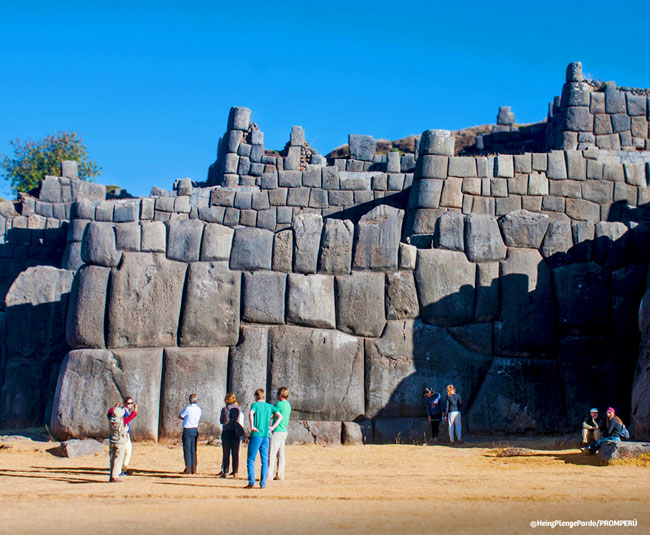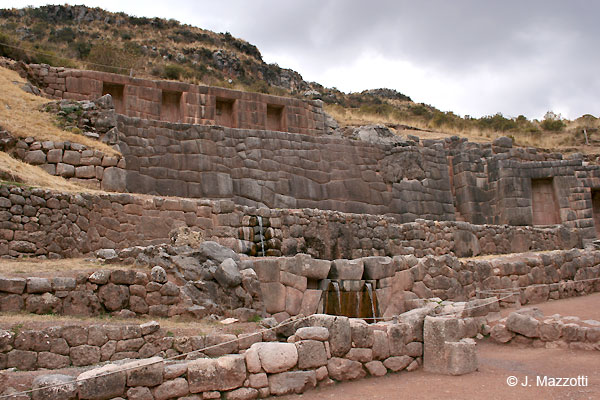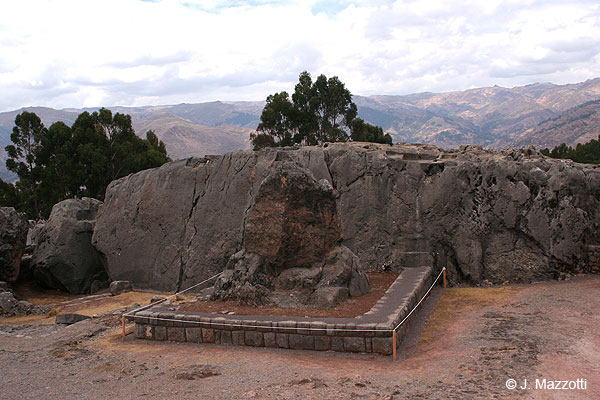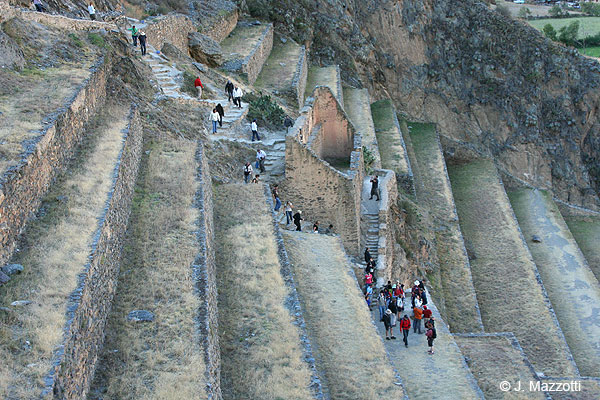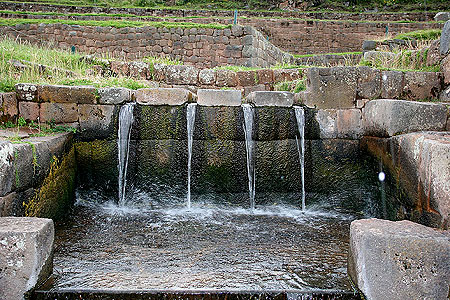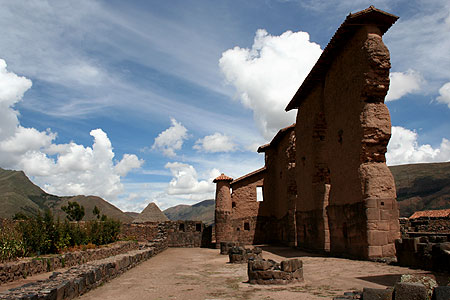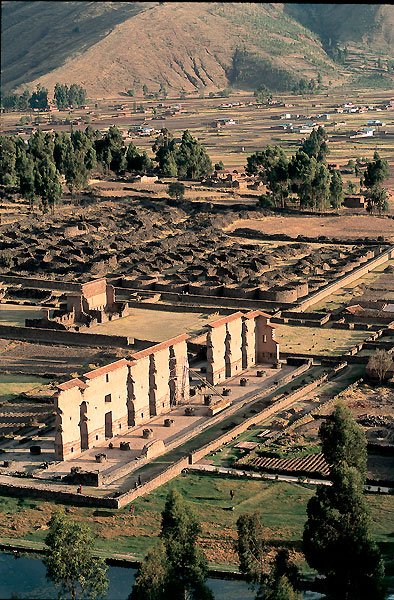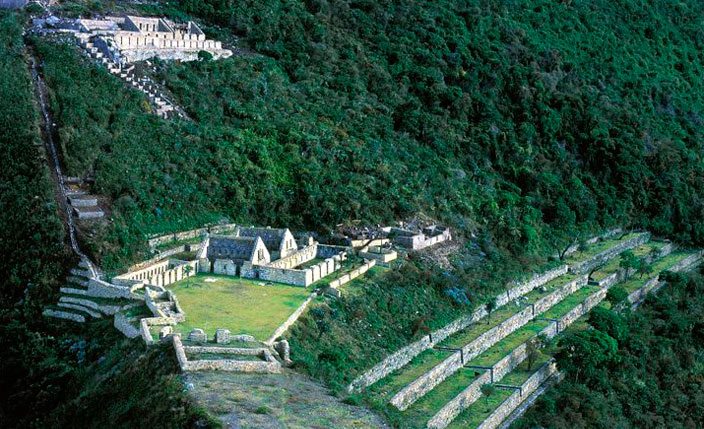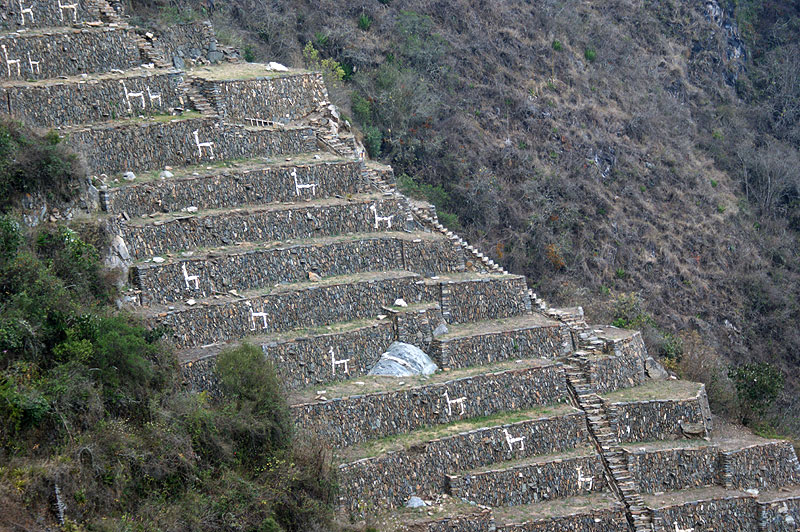Archaeological Places in Cusco

The territories that incorporated to the Inca domains were being ascribed according to its orientation regarding to the geographic, politic and sacred center of the Empire that was Cusco. The urban design of Cusco evokes the silhouette of a crouched puma and in it converged the Incas’ road net (Qhapaq Ñan - World Heritage Site 2014) that ran along the 40,000 sq. Km. of the Inca territory from north to south. Because of its historical and archaeological value, Cusco was declared World Heritage Site in 1983 (UNESCO).
In Pachacútec’s time, the center of the city was organized around the double Square of Huacaypata and Cusipata (at present San Francisco and Main Squares). These squares were surrounded by imperial palaces and temples, among the ones, stand out for their important and richness, the Koricancha. To the north-east of Huacaypata Square, it was probably, Pachacútec Palace Casana), from which there are still some pieces of wall.
ARCHAEOLOGICAL PARK OF SACSAYHUAMAN
4 Km north of Cusco city. It embraces 3,000 hectares approximately, where a rich Andean flora and extraordinary Inca and Pre-Inca archaeological monuments as Sacsayhuaman, Kencco (or Qenqo), Puca Pucará and Tambomachay. Visiting hours: Mon. – Sun. and holidays 7:00 A.M. – 6:00 P.M. These places need paid entrance.
The Sacsayhuaman Fortress
Built over a hill to the west of Cusco by tens of thousands of workers provided only with a few metal tools, the fortress sheltered a temple to the Sun built in carved stone. Constructed during the Túpac Inca Yupanqui, Huayna Capac and Huáscar reigns, this huge fortress comprises a series of staged platforms on the north esplanade that deserves the visitors most especial attention. Its cyclopean architecture required using huge and heavy carved stones that fit each other in almost invisible joints. Each of its three platform levels is over 200 meters long. At the summit, a series of buildings and terraces include three circular buildings comprises three concentric rings of walls. In this same sector were the Temple of the Sun and warehouses for weapons, soldiers’ clothes, base metals, silver, gold, covers and war materials. Other equally complex and interesting sectors complete this monumental site. In the sector known as “the slide”, carved stones in the shape of small altars and ramps deserve attention. These are vestiges of an artificial circular pond for ritual use, as well as several water canals and underground passages, with niches and small stairs carved on the walls. A huge carved stone called the “tired stone” finishes the list of remarkable sights.
The Kencco and Tambomachay Sanctuaries
Two places surrounding Cusco city that stand out for their ritual architecture are the sanctuaries of Kencco and Tambomachay. Kencco is a huge rockly mound with carved stairs, holes and gutters, probably made to deposit chicha (corn beer) drank during Inca rituals. This site is completed by a semicircular courtyard defined by an isometric wall with several large niches that surround a thin stone slab or wanka enclosed in a chamber, like an image inside its own chapel.
Tambomachay also known as the “Baños del Inca” or the Inca baths, Tambomachay was apparently a site dedicated to the worship of water and a resting place for the Inca monarch. Is a very remarkable place of refined architecture made up of platforms, niches and ponds still used today. The spillways carry water from a higher spring. In Inca times, it was a secret place devoted to the adoration of water, and one of the sanctuaries comprised in the ceques system of Cusco. The most important huacas (“huaca” means shrine) in the Cusco area can be seen from Tambomachay. One of them is Huanacaure, a sacred mountain that played a transcendental role in the mythical foundation of Cusco.
Puca Pucará
Inca archaeological location, located in the peak of a hill, was a military position and an administrative center. For its proximity to Tambomachay, it is believed that it had relationship with its defense, as well as the control of the route to Calca that led to the Antisuyo (Forest county of the Inca). It is a fortification formed by platforms, stairs, passages, turrets, windowsills and a wall that defends the whole construction in a circular shape. The complex holds numerous halls, inner plazas, aqueducts, watchtowers and paths. According to legend, each time the Inca visited Tambomachay, he was accompanied by a large committee that stayed in Puca Pucará. It is located at 7 Km (4 miles) north-east of Cusco city (15 minutes by car and 2 hours on foot).
Archaeological places to Southeast
This archaeological places are located to southeast of Cusco city, accessible by the highway from Cusco to Puno, called the Corridor of Manco Cápac.
Tipón
25 Km / 16 miles southeast of Cusco (45 minutes by car) on the tarred Cusco – Puno highway, taking the turnoff near kilometer marker 20,5. This beautiful compound of agricultural terraces, long stairs and stone canals. Apparently, Tipón was part of the royal estate belonging to Inca Yáhuar Huaca, and at the same time, a place devoted to religious adoration and agricultural experiments. The site’s functional and aesthetic harmony, typical of Quechua architects, is remarkable. They drove the water through fine stone structures, either in the form of aqueducts- some of them underground –or canals, falls and spillways.
Piquillacta
A pre-Inca city that reached its zenith between 800 - 1100 AD, in the period in which the Huari regional confederation developed. This constitutes the gateway into the Incas' Holy City. It consists of large, straight streets and long city blocks containing rectangular shaped buildings. The town is surrounded by walls and spherical structures on the west side. The walls are high, built with mud blocks and mortar, and foundations that change in depth depending on the wall's height. It is located at 30 km (19 miles) south of Cusco city (45 minutes by car).
Rumicolca
Inca archaeological area, located at 39 Km. (24.2 miles) southeast of Cusco and at 1 Km. (0.62 miles) of Piquillacta. It constituted the main and obligatory entrance to Cusco in the route to the Collasuyo (county of the south, in the Tahuantisuyo), with functions of customs. A great and imposing cover built in carved stone, surrounded with high walls in which inferior vertex a water channel runs, also a great aqueduct that was used to take water to the population of Piquillacta.
Raqchi - The Temple of Wiracocha
The largest and most beautiful temple built to commemorate Wiracocha Pchayachachi (maker of the wall) is found along the road to Sicuani (119 Km. south of Cusco - 2 hours by car - Route Cusco to Puno) in San Pedro de Cacha (3,485 m.a.s.l.). Raqchi had a great reputation as and was an important destination for pilgrims, a fact that explains the warehouses and other buildings around the temple that served as dwellings for priests, servants and the populace. Its rectangular layout with four large walls (92 m. long by 25 m. wide) features two entries on the south side and an altar in the side opposite the doors. Inside the temple, there is a longitudinal diving wall made of delicately carved stone and adobe bricks over 12 meters high. The internal structure is completed with 22 cylindrical columns made of carved adobes and holding the roof of this chamber more than 2.300 square meters large. Its walls were plastered and painted red. See rural tourism in Raqchi
Choquequirao
It is another "Lost City of the Incas" rediscovered officially late in 20th century located high on a ridge spur almost 1,750 m. above the raging glacier-fed Apurimac River and surrounded by towering Salkantay and Humantay snow-capped peaks.
Choquequirao (chuqui k'iraw, "cradle of gold") could be one of the lost citadels in the Vilcabamba Valley, where the Incas sheltered as of 1536. The complex features nine stone architectural groups, with hundreds of terraces, rooms and irrigation systems. The buildings are distributed around an esplanade or main plaza. It is located at 93 km (58 miles) from Abancay city (Apurímac region), is the village of Cachora, from here it is another 30 km (19 miles - 2 days on foot, hiking an average of 8 hours per day).
The Manco Inca dynasty resisted the Spanish conquerors during 40 years (1536 to 1572) from this fortress in the Vilcabamaba area. The Spanish conquerors were never able to expel them from it. The building of Choquequirao is the work of Inca Pachacútec successors Túpac Inca Yupanqui (1471-1493) and Huayna Capac (1493-1527). Household and ceremonial pottery has been found here that bears both the classic Cusco style and also from other populations who came to live here to build and permanently populate the area. Most likely, they were experienced farmers who knew how to build and use farming terraces in high Amazon forest areas. Located at 3.050 m.a.s.l. on the border with department of Apurímac, the Choquequirao archeological compound was not built to be a place of easy access.
Reaching it demands two days of disciplined march, largely compensated by the beauty of the landscape that wayfarers cross from the beginning of their expedition. The road starts at Cachora (2.300 m.a.s.l.), a small town in the Apurímac department, after traveling four hours on the mostly paved road from Cusco (145 Km. paved and 10 Km. of dirt road). Mule packers can be contacted there who can also act as guides. A local family offers accommodation and the only telephone in town. Approximately 40% of the Choquequirao Inca ceremonial center has been cleared of vegetation.
The remaining area is formed by a complex terrace system built on extremely steep slopes. A very impressive stairway of 180 terraces has been recently spotted. It descends from one of the ceremonial center flanks and reaches the river open to swimming. Choquequirao was probably one of the entrance check point to the Vilcabamba region, and also an administrative hub serving political, social and economic functions. Its urban design has followed the symbolic patterns of the imperial capital, with ritual places dedicated to the Sun (Inti) and the ancestors, to the earth, water and other divinities, with mansions for administrators and houses for artisans, warehouses, large dormitories or kallankas and farming terraces belonging to the Inca or the local people. Spreading over 700 meters, the ceremonial area drops as much as 65 meters from the elevated areas to the main square.
Choquequirao







